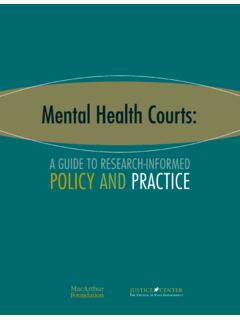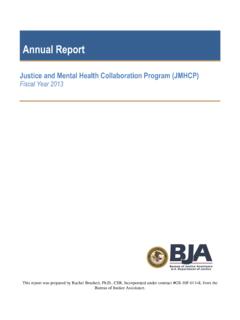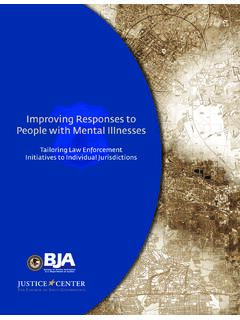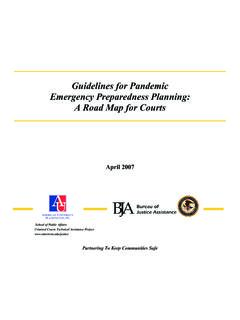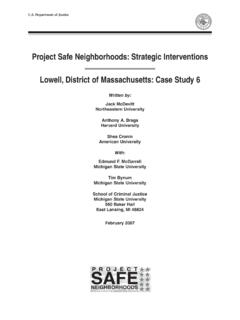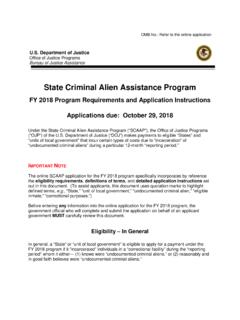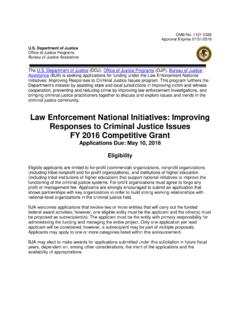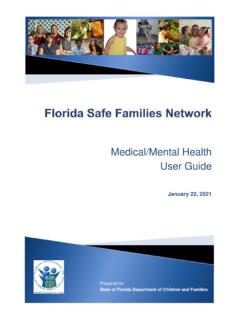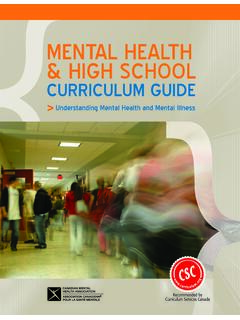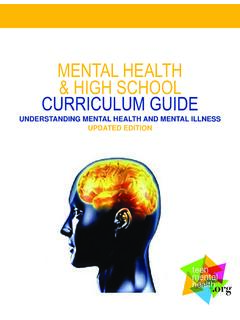Transcription of Guide to Design - Bureau of Justice Assistance - Home
1 A Guide to mental health CourtDesign and ImplementationBJAmentalhealthcourtsprogr amThe Council of State Governments (CSG) is a nonprofit, nonpartisan organization that serves all three branches of state government. Founded in 1933, CSG has a long history of providing state leaders with the resources to develop and implement effective public policy and programs. Owing to its regional structure and its constituency which includes state legislators, judges, and executive branch officials CSG is a unique organization.
2 Comparable associations oper-ate only on a national level and target one branch of state government exclusively. The development of this Guide was overseen by staff of the Criminal Justice Program of CSG s Eastern Office, which also coordinates the Criminal Justice / mental health Consen-sus the Council of State GovernmentsCoordinated by the Council of State Governments (CSG), the Criminal Justice / mental health Consensus Project is an unprecedented national effort to improve the response to people with mental illnesses who become involved in, or are at risk of involvement in, the criminal Justice system.
3 The landmark Consensus Project Report, which was authored by CSG and representatives of leading criminal Justice and mental health organizations, was released in June 2002. Since then, the Consensus Project has continued to promote practical, flexible approaches to this issue through presenta-tions, technical Assistance , and information dissemination. This includes providing technical Assistance to the Bureau of Justice Assistance mental health Courts the Criminal Justice / mental health Consensus Project The Office of Justice Programs, US.
4 Department of Justice , was created in 1984 to provide federal leadership in devel-oping the nation s capacity to prevent and control crime, administer Justice , and assist crime victims. OJP carries out this mission by forming partnerships with other federal, state, and local agencies, as well as national and community-based organizations. OJP is dedicated to comprehensive approaches that empower communities to address crime, break the cycle of substance abuse and crime, combat family violence, address youth crime, hold offenders accountable, protect and support crime victims, enhance law enforce-ment initiatives, and support advancements in adjudication.
5 OJP also works to reduce crime in Indian Country, enhance technology s use within the criminal and juvenile Justice sys-tems, and support state and local efforts through technical Assistance and training. the Office of Justice Programs (OJP) The Bureau of Justice Assistance (BJA), Office of Justice Programs, Department of Justice , supports law en-forcement, courts, corrections, treatment, victim services, technology, and prevention initiatives that strengthen the nation s criminal Justice system.
6 BJA provides leadership, ser-vices, and funding to America s communities by emphasizing local control; building relationships in the field; developing collaborations and partnerships; promoting capacity build-ing through planning; streamlining the administration of grants; increasing training and technical Assistance ; creating accountability of projects; encouraging innovation; and ultimately communicating the value of Justice efforts to decisionmakers at every level. the Bureau of Justice Assistance (BJA) A Guide to mental health Court Design and ImplementationA publication of the Council of State Governments, prepared for the Bureau of Justice AssistanceA Guide to mental health Court Design and ImplementationThe Council of State GovernmentsMay 2005 Several authors contributed to the content of this Guide .
7 Alan Henry developed an early draft, Daniel Souweine made substantial additions, and Kelly Dedel Johnson offered con-structive revisions and managed the editing and process. In addition to the authors, many people and organiza-tions helped make this Guide possible. CSG thanks the Bu-reau of Justice Assistance for its support, and recognizes the guidance and input of Michael Guerriere, Senior Policy Advi-sor for Substance Abuse and mental health , who served as the grant manager for this project.
8 CSG is continually grateful for the ongoing leadership of Representative Michael Lawlor (Connecticut) and Senator Robert Thompson (Pennsylvania), co-chairs of the Criminal Justice / mental health Consensus Project, who have guided CSG s work in this field. CSG also thanks the representatives of mental health courts across the country, particularly those that received BJA funding. These courts graciously provided information about their activities, accommodated site visits, and shared their insights.
9 Their experience and expertise added depth and dimension to this used a peer review process to ensure the relevance and usefulness of this Guide . Vicki Downing, Barry Mahoney, Maldonado, Judge Stephanie Rhoades, and Dr. Erik Ro-skes contributed valuable time, proposed text, recommended resources, and offered suggestions on matters of format and style. Their input resulted in substantive improvements to the final Katz copy edited the Guide and Dave Williams designed its would like to thank Daniel Souweine, who, using extensive knowledge developed through his visits and meet-ings with numerous mental health court professionals and lengthy conversations with a broad array of experts in the field, wrote much of this document.
10 Over a 3-year period, Daniel s contributions and leadership were crucial to the success of the Consensus Project. CSG is especially grateful for Daniel s commitment to seeing this document through to its completion by serving as a consultant to the Consensus Project team after his tenure at CSG citation: Council of State Governments. A Guide to mental health Court Design and Implementation. New York, NY: Council of State Governments, 2005. This Guide was prepared by the Council of State Governments under grant number 2003-DD-BX-K007, awarded by the Bureau of Justice Assistance , Office of Justice Programs, Department of Justice .
